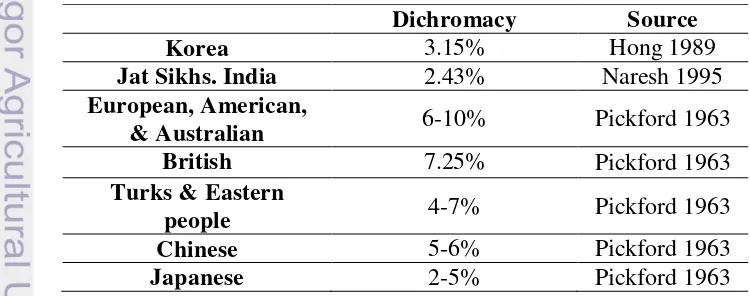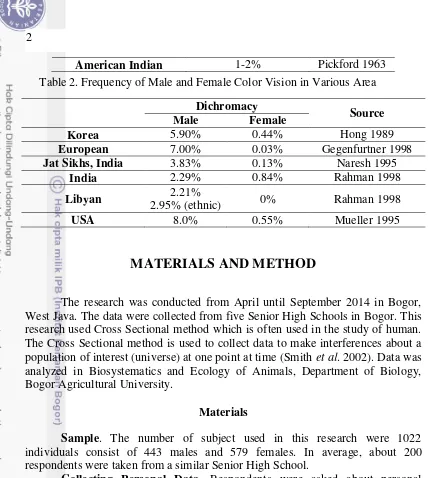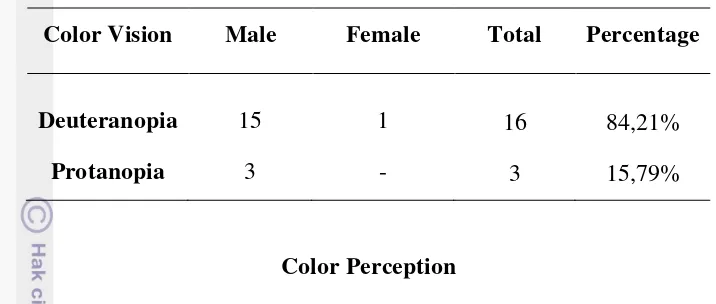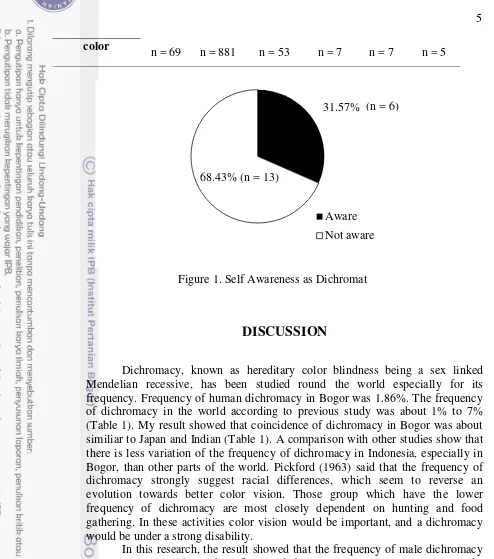THE VARIATION OF HUMAN COLOR VISION
IN BOGOR
RULLY SETIANA
DEPARTMENT OF BIOLOGY
FACULTY OF MATHEMATHIC AND SCIENCE BOGOR AGRICULTURAL UNIVERSITY
PERNYATAAN MENGENAI SKRIPSI DAN
SUMBER INFORMASI SERTA PELIMPAHAN HAK CIPTA
Dengan ini saya menyatakan bahwa skripsi berjudul The Variation of Human Color Vision in Bogor adalah benar karya saya dengan arahan dari komisi pembimbing dan belum diajukan dalam bentuk apa pun kepada perguruan tinggi mana pun. Sumber informasi yang berasal atau dikutip dari karya yang diterbitkan maupun tidak diterbitkan dari penulis lain telah disebutkan dalam teks dan dicantumkan dalam Daftar Pustaka di bagian akhir skripsi ini.
Dengan ini saya melimpahkan hak cipta dari karya tulis saya kepada Institut Pertanian Bogor.
ABSTRAK
RULLY SETIANA. Variasi Penglihatan Warna pada Manusia di Kota Bogor. Dibimbing oleh KANTHI ARUM WIDAYATI dan BAMBANG SURYOBROTO.
Trichromacy pada manusia bergantung pada tiga jenis opsin yang berbeda. Tidak ada atau tidak berfungsinya salah satu dari opsin tersebut menyebabkan dichromacy. Dichromacy pada manusia telah dipelajari tentang variasi dan frekuensinya. Pada penelitian ini, saya mengobservasi variasi dari penglihatan warna pada manusia beserta frekuensinya di kota Bogor. Belum ada penelitian tentang penglihatan warna pada manusia beserta frekuensinya di Indonesia, khususnya di kota Bogor. Saya menggunakan metode sampling Cross Sectional pada 443 laki-laki dan 579 perempuan. Responden tersebut diperiksa menggunakan Tes Ishihara. Hasil dari penelitian menunjukkan bahwa frekuensi dichromacy pada manusia di kota Bogor adalah sebesar 1.86%. Frekuensi dichromacy pada laki-laki sebesar 4.06% dan dichromacy pada perempuan sebesar 0.17%., dan hanya 31.57% dari responden tersebut yang sadar bahwa diri mereka adalah dichromat. Hasil tersebut hampir sama dengan frekuensi dichromacy di Asia dan wilayah timur lainnya tetapi lebih rendah dibandingkan frekuensi dichromacy di Eropa, America, dan wilayah barat lainnya.
Kata kunci: Bogor, penglihatan warna, variasi.
ABSTRACT
RULLY SETIANA. The Variation of Human Color Vision in Bogor. Supervised by KANTHI ARUM WIDAYATI and BAMBANG SURYOBROTO.
Skripsi
sebagai salah satu syarat untuk memperoleh gelar Sarjana Sains
pada
Departemen Biologi
THE VARIATION OF HUMAN COLOR VISION
IN BOGOR
RULLY SETIANA
DEPARTMENT OF BIOLOGY
FACULTY OF MATHEMATIC AND SCIENCE BOGOR AGRICULTURAL UNIVERSITY
PRAKATA
Puji dan syukur penulis panjatkan kepada Allah subhanahu wa ta’ala atas segala karunia-Nya sehingga karya ilmiah ini berhasil diselesaikan. Tema yang dipilih dalam penelitian yang dilaksanakan sejak bulan April 2014 ini ialah penglihatan warna, dengan judul The Variation of Human Color Vision in Bogor.
Terima kasih penulis ucapkan kepada Dr Kanthi Arum Widayati dan Dr Bambang Suryobroto selaku pembimbing. Di samping itu, penghargaan penulis sampaikan kepada seluruh pihak sekolah yang menjadi sampel dalam penelitian saya, yang telah membantu selama pengumpulan data. Ungkapan terima kasih juga disampaikan kepada ayah, ibu, serta seluruh keluarga dan teman-teman, atas segala doa, kasih sayang, dan dukungannya.
Semoga karya ilmiah ini bermanfaat.
DAFTAR ISI
DAFTAR TABEL vi
DAFTAR GAMBAR vi
DAFTAR LAMPIRAN vi
INTRODUCTION 1
MATERIALS AND METHOD 2
Materials 2
Methods 2
RESULT 3
Color Vision 3
Color Perception 4
DISCUSSION 5
CONCLUSION 6
REFERENCES 7
APPENDIX 9
DAFTAR TABEL
Coincidence of Dichromacy in Various Area ... 1
Frequency of Male and Female Color Vision in Various Area ... 2
Result of Ishihara Test ... 3
Dichromacy Variation and Frequency ... 4
Determining Color Vision ... 4
DAFTAR GAMBAR
Self Awareness as Dichromat ... 5DAFTAR LAMPIRAN
Informed Consent ... 9INTRODUCTION
With hundreds of genes, the X chromosome plays some important roles in determining human appearance. Certain genes are found on sex chromosome, these genes are called sex-linked genes. One of its responsibillity is determining human color vision (Chiras 2012). Most human possess trichromatic color vision. Human trichromacy relies on three different opsin types in the retina; long- (L/ Red), middle- (M/ Green), and short- (S/ Blue) wavelength-sensitive (Alcamo 1998). Each opsin gene is encoded by different gene. The genes M and L that produce opsin pigments are encoded by genes that reside in X chromosome (Carroll et al. 2004), while gene S resides in 7th autosome (Wong 2011).
Other than trichromacy, there are some variations in human color vision, they are Dichromacy and Monochromacy. These color vision variations resulted from the functional loss of one or more opsin class. Dichromacies resulted from a loss function of one of the three opsin photoreceptor types, and come in three corresponding forms; those are Protanopia, Deuteranopia, and Tritanopia (Byrne et al. 1997; Neitz & Neitz 2011). Protanopia is color vision caused by the lack of L opsin, and Deuteranopia is caused by the absence of M opsin. People are often called Protanopia and Deuteranopia as red-green color blindness type. Tritanopia is a blue-yellow color blindness type. It is a very rare color vision in which there are only two opsins present (M and L), and a total absence of S opsin (Kaiser & Boynton 1996). Those with tritanopia have difficulty to determine between blueish and yellowish hues. Monochromacy is the most rare color vision. It is caused by opsin defect/absence when three of opsin pigments are missing. People with monochromacy will be lack of ability to distinguish colors. The person views everything as if it is on a black and white television (Gegenfurtner & Sharpe 2001).
Previous studies about frequency of dichromacy showed on Table 1 and Table 2. There were some advantages of being a dichromat, such as a better vision to find a specific objects in dappled background or color camouflage. To the best of our knowledge, we still have no exact data for frequency of each color vision types in Indonesia. Since Indonesia is more diverse and multi ethnic, this study is an initial research that is trying to find the frequency of color vision variations of human in Bogor, West Java.
Table 1. Coincidence of Dichromacy in Various Area
Dichromacy Source Korea 3.15% Hong 1989
Jat Sikhs. India 2.43% Naresh 1995
European, American,
& Australian 6-10% Pickford 1963 British 7.25% Pickford 1963
Turks & Eastern
people 4-7% Pickford 1963 Chinese 5-6% Pickford 1963
2
American Indian 1-2% Pickford 1963 Table 2. Frequency of Male and Female Color Vision in Various Area
Dichromacy
Source Male Female
Korea 5.90% 0.44% Hong 1989
European 7.00% 0.03% Gegenfurtner 1998
Jat Sikhs, India 3.83% 0.13% Naresh 1995 West Java. The data were collected from five Senior High Schools in Bogor. This research used Cross Sectional method which is often used in the study of human. The Cross Sectional method is used to collect data to make interferences about a population of interest (universe) at one point at time (Smith et al. 2002). Data was analyzed in Biosystematics and Ecology of Animals, Department of Biology, Bogor Agricultural University.
Materials
Sample. The number of subject used in this research were 1022 individuals consist of 443 males and 579 females. In average, about 200 respondents were taken from a similar Senior High School.
Collecting Personal Data. Respondents were asked about personal information such as name, address, gender, ethnic group, and the pedigree of the respondents to determine if they have family members who are dichromat.
Methods
3 dichromacy (protanope or deuteranope). Inspection time for plate 1 to 10 was only 3 seconds, but for the eleventh to twelfth was up to 10 seconds.
Color Perception. In determining color perception, respondents were asked to fill a questionnaire consisted of questions about determining color in daily life. The answers of respondents show the difference in color perception between dichromat and trichromat.
Data Analysis. I analyzed Ishihara Test result. Each plate of Ishihara Test shows the result of color vision test. If a respondent mistaken a number of a plate less than three times, it means that the respondent is a thrichromat. But if they got mistake a number of a plate more than three times, the respondent is predicted as a dichromat. The tenth to twelfth plates contain number and curves which determine the type of dichromacy. Whereas the result of questionnaire was analyzed to show the pedigree of both of dichromat and trichromat and the color vision perception.
RESULT
Color Vision
The frequency of trichromat was high that is 98.14% (1003 trichromats consist of 425 males and 578 females). I found only 1.86% dichromats (19 out of 1022) (Table 3). The frequency of male dichromats was 4.06% (18 out of 425
Table 3. Result of Ishihara Test
4
Table 4. Dichromacy Variation and Frequency
Color Vision Male Female Total Percentage
Deuteranopia 15 1 16 84,21%
Protanopia 3 - 3 15,79%
Color Perception
The result from questionairre showed that most people have argumentation with another person in determining color. About 64.50% trichromat and 68.42% dichromat said that they had had an argumentation with another person in determining color. There were 28.91% trichromat and 31.58% dichromat whose not having argument in determining color (Table 5). This number showed that trichromat having argument in determining color. It is normal as a human to argue eventhough most trichromat have less or did not have any difficulties in determining color (87,83%) compare to that in dichromat (36,84%). The percentage of difficulties in determining color was smaller than the percentage of argumentation in determining color. It shows that only a few people think that they have a problem in their color vision. About 93% samples said that these troubles appear very rare or never.
5
Figure 1. Self Awareness as Dichromat
DISCUSSION
Dichromacy, known as hereditary color blindness being a sex linked Mendelian recessive, has been studied round the world especially for its frequency. Frequency of human dichromacy in Bogor was 1.86%. The frequency of dichromacy in the world according to previous study was about 1% to 7% (Table 1). My result showed that coincidence of dichromacy in Bogor was about similiar to Japan and Indian (Table 1). A comparison with other studies show that there is less variation of the frequency of dichromacy in Indonesia, especially in Bogor, than other parts of the world. Pickford (1963) said that the frequency of dichromacy strongly suggest racial differences, which seem to reverse an evolution towards better color vision. Those group which have the lower frequency of dichromacy are most closely dependent on hunting and food gathering. In these activities color vision would be important, and a dichromacy would be under a strong disability.
In this research, the result showed that the frequency of male dichromacy in Bogor was 4.06%, while female dichromacy in Bogor was 0.17%. The frequency of male dichromat in this study was less than the frequencies of male dichromat in European, American, and Korean males. But the number was higher than the frequency of male dichromat in India and Libyan (Table 2). Similliar case happen to the comparison for frequency of female dichromat in Bogor was higher than European female and Libyan female. But the frequency was less than frequency of female dichromat in America, Korea, and India (Table 2). As only one female was found to be a dichromat, it was not possible to conclude regarding frequency of female dichromat. To find the exact frequency of dichromacy in females, a further study with a large sample is required (Naresh 1995).
6
The frequency of dichromacy is much more in male as compared to female. As dichromacy was a hereditary, the genes which determining human color vision was reside in X chromosome (Carrol et al. 2004). This is the reason that dichromacy occured in males than females. A female rely color vision on two X chromosomes (XX) while a male had only one X chromosome (XY), which caused a female with only one lacking opsin of color vision supposed to be a dichromacy covered by another X chromosome become a gene carrier for its heredity. A female could be a dichromat only if both the X chromosomes lacking genes that produce opsin pigments which determining human color vision.
John Dalton, the first scientist who publicated about dichromacy, was a dichromat. His paper was concerned with his own affliction of his color vision and stimulated much subsequent research into pathophysiology and genetics of the condition. Through his studies of botany, he had become aware that he could not distinguish certain color (Emery 1988). The percentage of sample who did not recognized that they are a dichromat was very high. This number caused by unaware of color vision. It is so important, though, for knowing a person is a dichromat or trichromat which determine people to choose their school, education, or a job.
Nevertheless, Mollon (1989) write on his paper that a dichromat also have advantage. A dichromat have a better detection of targets against dappled backgrounds. Morgan et al. (1992) also write about advantage of being a dichromat. They said that dichromat surprisingly have a better vision in breaking certain kinds of color camouflage. Dichromats also had enhanced scotopic vision as compared with trichromats, which suggests dichromats can see better at under scotopic conditions, such as dusk, dawn, and moonlit nights (Verhulst & Maes 1998). This is likely to provide a selective advantage, for example because enhanced scotopic vision makes it easier to detect nocturnal predators, as humans are group-living animal who benefit from each other’s success in finding food and detecting predators, and to forage or fight in low light condition. At low temporal frequencies, dichromats have significantly higher (twofold) threshold for all colored stimuli than thrichromats. The advantages of dichromats in detecting high temporally modulated targets can be related to an increased number, through replacement, of the remaining L- or M-cone type (Sharpe et al. 2006). These citations showed that a dichromat is not always less than a trichromat, a dichromat also have a better side than a trichromat.
CONCLUSION
7
REFERENCES
Alcamo E. 1998. Biology Coloring Workbook. New York (US): Princeton Review Publishing.
Byrne A, Hilbert DR. 1997. Readings on Color: The science of color. Massachusetts (US): Massachussets Institute of Technology.
Carroll J, Neitz M, Hofer H, Neitz J, Williams D. 2004. Functional photoreceptor loss revealed with adaptive optics: An alternate cause of color blindness. Journal of The American Chemical Society 101(22): 8461-8466.
Chiras D. 2012. Human Biology 7th Edition. London (GB): Jones & Bartlett Learning International.
Emery AEH. 1988. Portraits in medical genetics. Journal of Medical Genetics 25: 422-426.
Gegenfurtner KR, Wichmann FA, Sharpe LT. 1998. The Contribution of Color to Visual Memory in X-chromosome-linked Dichromats. Vision Research 38(7): 1041-1045.
Gegenfurtner KR, Sharpe LT. 2001. Color vision: From genes to perception. Cambride (UK): Cambridge University Press.
Hong BK, et al.. 1989. The Incidence of Congenital Color Deficiency among Koreans. Journal of Korean Medical Science 4(3): 117-120.
Ishihara S. 1968. Examine List for Color Vision Deficiency for School. Tokyo (JP): Masanori Yamaguchi Publisher.
Kaiser PK, Boynton RM. 1996. Human color vision. Washington DC (US): Optical Society.
Mollon JD. 1989. Tho’ She Kneel’d in That Place Where They Grew... The Uses and Origins of Primate Colour vision. Journal Exp Biol. 146: 21-38. Morgan MJ, Adam A, Mollon JD. 1992. Dichromats Detect Color-Camouflaged
Objects that Are Not Detected by Trichromats. Proc. R. Soc. Lond. B 248: 291-295.
Mueller RF. 1995. Emery’s Element of Medical Genetic 9th Edition. Edinburgh (US): Churcill Livingstone.
Naresh S. 1995. Study of Color Blindness in Jat Sikhs. Indian J Physiol Pharmacol 39(2): 127-130.
Neitz J, Neitz M. 2011. The genetics of normal and defective color vision. Vision Research 51(5): 633-651
Pickford RW. 1963. Natural Selection and Colour Blindness. The Eugenics Review 55(2): 97-101.
Rahman SA, Singh PN, Nanda PK. 1998. Comparison of the Incidence of Colour Blindness between Section of Libyan and Indian Population. Indian J Physiol Pharmacol 42(2): 271-275.
Sharpe LT, Luca DL, Hansen T, Jagle H, Gegenfurtner KR. 2006. Advantages and disadvantages of human dichromacy. Journal of Vision 6: 213-223. Smith SM, Zhang Y, Jenkinson M, Chen J. 2002. Accurate, robust, and automated
8
Verhulst S, Maes FW. 1998. Scotopic vision in colour-blinds. Vision Research 38: 3387-3390.
9
Jalan Meranti Kampus IPB Dramaga, Bogor, Telp/ fax, dekanat (0251) 8625481
8625708 Website: www.ipb.ac.id. Email:
dekan_fmipa@ipb.ac.id
INFORMED CONSENT
Bapak/Ibu saudara/i yth.
Dalam rangka pengumpulan data untuk penelitian mandiri mengenai The Variation of Human Color Vision in Bogor, maka Saya:
Nama : Rully Setiana Pekerjaan : Mahasiswa NIM : G34100125
Alamat : Jalan Perwira no 47 Dramaga Bogor
Memohon kesediaan bapak, ibu, dan saudara/i untuk memberikan persetujuan/ijin kepada Saya untuk melakukan pengambilan data berupa tes buta warna dan kuesioner terhadap bapak, ibu, dan saudara/i.
Penelitian ini dilatarbelakangi oleh kurangnya data tentang variasi persepsi warna dan frekuensinya untuk orang Indonesia khususnya di Kota Bogor.
Hasil penelitian ini nantinya akan sangat bermanfaat untuk mengetahui variasi persepsi warna beserta frekuensinya yang terdapat di Kota Bogor.
Saya menjamin bahwa semua keterangan yang saya peroleh dari penelitian ini akan dijaga kerahasiaannya dan tidak akan digunakan atau disebarluaskan ke pihak manapun kecuali untuk kepentingan pendidikan dan ilmu pengetahuan.
Demikian, atas bantuan dan kerjasamanya, Saya ucapkan banyak terima kasih.
10
KESEDIAAN MENGIKUTI PENELITIAN
Setelah diberi penjelasan mengenai penelitian yang berjudul “The Variation of Human color Vision in Bogor”, maka Saya:
Nama : ___________________________________ Jenis Kelamin : ___________________________________ Alamat : ___________________________________ Menyatakan BERSEDIA dengan sukarela untuk ikut serta dalam penelitian ini. Saya mendapat jaminan dari peneliti utama, yaitu Rully Setiana (ianbio47@gmail.com/081280087703) , bahwa identitas dan data yang saya berikan hanya akan digunakan untuk keperluan penelitian dan tidak diberikan ke pihak lain siapapun, kapanpun, dan untuk kepentingan apapun. Saya juga mendapat jaminan bahwa saya bisa menarik diri dari penelitian ini kapan saja dan dengan demikian data saya tidak akan dipakai.
Bogor, ____________
Subjek Penelitian
11
Jalan Meranti Kampus IPB Dramaga, Bogor, Telp/ fax, dekanat (0251) 8625481
8625708 Website: www.ipb.ac.id. Email: dekan_fmipa@ipb.ac.id
KUESIONER PENELITIAN
12
D. PERSEPSI WARNA
1. Apakah anda pernah berargumentasi dengan seseorang tentang suatu warna?
(Ya/ Tidak/ Tidak Tahu)
2. Apakah anda pernah mengalami kesulitan dalam membedakan warna? (Ya/ Tidak/ Tidak Tahu)
3. Dengan kesukaran dalam membedakan warna, apakah anda pernah merasa bahwa anda buta warna?
(Ya/ Tidak/ Tidak Tahu)
4. Pada usia berapa anda merasa/ sadar bahwa anda buta warna? Jawab : ...
5. Apakah anda memiliki penyebutan nama warna yang berbeda dengan teman di sekitar anda?
(Ya/ Tidak/ Tidak Tahu)
6. Apakah anda mengalami kesulitan menyebutkan nama/ mengenali warna-warna soft atu tergradasi?
(Ya/ Tidak/ Tidak Tahu)
7. Apakah anda pernah mengalami permasalahan dengan warna pada kegiatan sehari-hari?
(Ya/ Tidak/ Tidak Tahu)
8. Seberapa sering permasalahan anda muncul? a. Setiap hari
b. Beberapa kali dalam seminggu c. Sekali seminggu
d. Beberapa kali dalam sebulan e. Sekali sebulan
f. Beberapa kali dalam setahun g. Sangat jarang
13
RIWAYAT HIDUP
Penulis dilahirkan di Sragen Jawa Tengah pada tanggal 4 April 1992 dari ayahanda Agus Margono dan ibunda Ratmini. Penulis merupakan anak pertama dari dua bersaudara. Tahun 2010 penulis lulus dari SMA Negeri 1 Sragen dan berhasil masuk Departemen Biologi FMIPA IPB melalui jalur SNMPTN.



